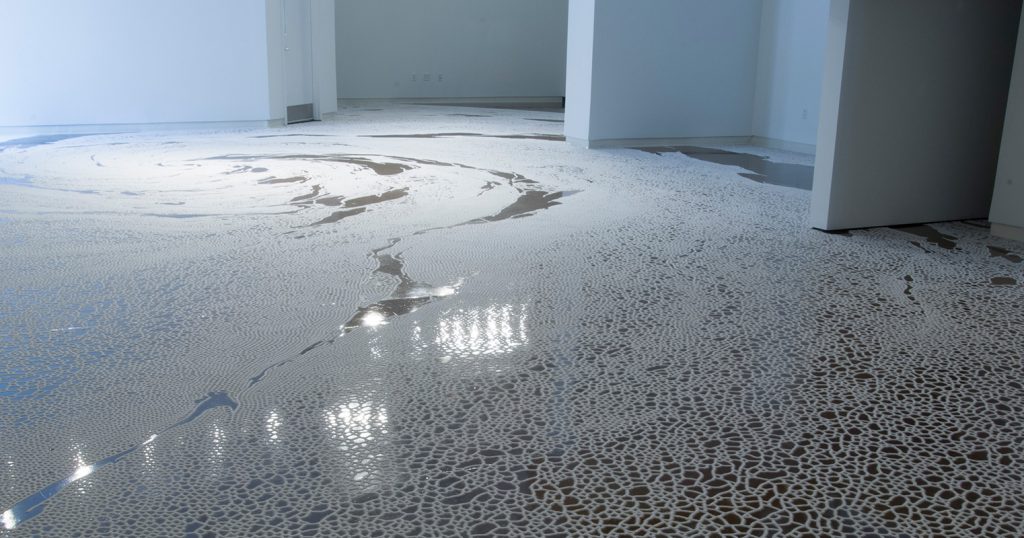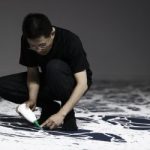

Japanese artist Motoi Yamamoto is something of a magician. Although he does not utilize sleight of hand, he creates installations that encourage the mind to travel between astonishment and wonder. His medium is salt, yet the effect of his labors is transcendence. Not an easy feat.
The field of modern and contemporary art is crowded with artists who have worked with unconventional materials. From Meret Oppenheim’s mink-lined teacup to Joseph Beuys’s felt and suet, to Wolfgang Laib’s use of bee pollen, the list is endless. Enter Motoi Yamamoto. He uses salt to create mental maps, miniatures of the mind. Yet, in his case, he doesn’t seem to choose materials merely for the sake of novelty or originality.
Motoi Yamamoto is known for working with salt, often in the form of temporary, intricate, large-scale installations. He has created projects throughout the world—Jerusalem, New York, Tokyo, Mexico City, Athens, Seoul, Toulouse, Hamburg, and Charleston, to name but a few places. Salt, a traditional symbol for purification and mourning in Japanese culture, is employed in funeral rituals as well as by sumo wrestlers before matches. It is frequently placed in small piles at the entrance to restaurants and other businesses to ward off evil spirits and to attract benevolent ones. Motoi forged a connection to the element while mourning the death of his sister, at twenty-four, from brain cancer, and began to create art out of salt in an effort to preserve his memories. His art radiates an intense beauty and tranquility, but also conveys something ineffable, yet endless.
Motoi views his installations as exercises that are at once futile yet necessary to his healing. An important aspect of the installation is the dismantling of his work at the end of each show and delivering the salt back to water, usually in collaboration with the public; hence, the title Return to the Sea.
He recognizes that salt is a vital part of many living things, and that this mineral could conceivably enter and leave multiple organisms throughout the planet over the span of time. Each grain of salt contains its own history and trajectory. Something so seemingly common becomes a metaphor for the evanescence and transience of human life.
Yamamoto’s art might most productively be compared to the intricate sand mandalas created by Tibetan Buddhist monks. In both cases, the work is destroyed at the end of a predetermined interval and returned to a body of water thus enacting the circularity and ephemerality of life. Both are used to induce meditation and to access the deeper reaches of human consciousness. One important difference is that Yamamoto’s work emanates from a powerful personal experience rather than a shared spiritual tradition.
The book and video that accompany this exhibition take measure of Motoi Yamamoto’s engagement with salt installations since he began making them in 2000. By showing the range of works he has produced, we seek to chart the artist’s journey of healing as he explores these different forms of expression. As Mark Kurlansky states in his essay, salt has a very rich and noble history entwined with Japan’s development as a world power. Knowing its myriad uses in Japanese culture makes it less of a common, everyday substance and more of a mercurial one. Its snow-white purity, combined with the uniformity of the grains, provides Yamamoto with a material at once literal and poetic— loaded with associational possibilities.
Yamamoto’s artistic trajectory is full of innovations and surprises. His ability to adapt his concepts to the various configurations and idiosyncrasies of the galleries and exhibition spaces that have displayed his work itself serves as a source of inspiration. His subtle use of gradation and perspective may cloud the mind into thinking this could be a mountain range as seen from the air, or a typhoon out in the open ocean. The real power and magic of Yamamoto’s work resides in the indeterminate space between what is and what might be.
Mark Sloan
Director and Senior Curator
Halsey Institute of Contemporary Art

Motoi Yamamoto is an internationally renowned artist who calls his native Japan home. He was born in Onomichi, Hiroshima in 1966 and received his BA from Kanazawa College of Art in 1995. He has exhibited his award-winning creations around the globe in such cities as Athens, Cologne, Jerusalem, Mexico City, Seoul, Tokyo, and Toulouse. He was awarded the Philip Morris Art Award in 2002 as well as the Pollock-Krasner Foundation Grant in 2003. Although he participated in a group exhibition that same year at New York’s P.S. 1, his work has yet to be widely seen in the United States.
Yamamoto says, “Drawing a labyrinth with salt is like following a trace of my memory. Memories seem to change and vanish as time goes by; however, what I seek is to capture a frozen moment that cannot be attained through pictures or writings. What I look for at the end of the act of drawing could be a feeling of touching a precious memory.”